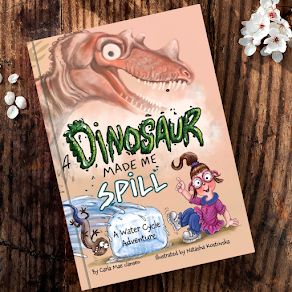Sharks are HUGE! Great white sharks can be more than 20 feet long and weigh more than 2,000 pounds! How does a 2,000 pound critter float through the ocean? This science experiment shows a big part of that answer! (This is our second shark floating science project...you can see the first shark floating experiment here.)
Truthfully, some sharks do sink! Nurse sharks will rest on the bottom of the ocean and still breathe by sucking water across their gills as they rest. All sharks will sink if they stop moving. Some sharks, like the great white, can only breathe while they are moving! So, how do these huge sharks manage to float?!
We're going to talk about three main ways:
1- Cartilege Skeleton
2- Fin Shape
3- Oily Liver
1- Sharks' cartilege skeletons weigh a lot less than bones! The lighter weight makes floating easier, but it isn't the whole answer!
2- Sharks' fin shape is crucial! But we have an experiment for that here!
Fun Fact: Sand tiger sharks can take air into their stomachs so they can actually float while barely moving...it looks like they're floating motionless in the water!
3- Sharks' oily liver is the third key in how sharks float! Oil will float on water because it is less dense. Check out this fish experiment and this penguin experiment for more fun with density, oil, and water! Sharks' huge oil-filled liver can weigh 30% of their body weight! Imagine a 2100 pound shark...700 pounds of its weight is made just from oil in its liver! Combined with a shark's cartilege skeleton and fin shape, this oil-filled liver makes it so the shark does not sink! Try this experiment to see the difference oil can make:
Simple Supplies:
* 2 balloons
* oil
* water
* a big tub filled with water
* (optional) sharpie marker
* (optional) dish soap
* (optional) sharpie marker
* (optional) dish soap
Easy How-To:
1- Fill one balloon with water and one balloon with oil. (To make it even more dramatic, use dish soap instead of water!) I used 12 inch balloons and only put about 1/4 cup of liquid in the balloons so they are less likely to break!
Note: Be careful not to get very much air in your water-filled balloon. Air will make your water-balloon float, which will confuse your experiment! Alternatively, you could make a third balloon with water and a lot of deliberate air and see what happens!
Note: Be careful not to get very much air in your water-filled balloon. Air will make your water-balloon float, which will confuse your experiment! Alternatively, you could make a third balloon with water and a lot of deliberate air and see what happens!
2- I drew sharks on our balloons since that was what we were talking about in the first place! (Plus, Shark Week is just around the corner!)
The water-filled balloon (yellow) will sink below the surface of the water. Depending on how much air snuck into the balloon, you may have a tiny part of the balloon touching the surface of the water.
The oil-filled balloon (representing sharks' oil-filled livers) floated right at the surface. We may have even had a toy beluga sit on top of the oil-filled shark, and it still floated! (Sorry, no picture of that!)
This is an easy extension of the classic float/sink experiment that preschoolers LOVE to do over and over, but I found that even older kids loved this variation. I think they appreciate seeing the application in real life. You can also extend this by asking what other animals use oil or fat to help float.
Either way, you will probably have kids wanting to fill balloons with all sorts of materials to see what happens next!
Either way, you will probably have kids wanting to fill balloons with all sorts of materials to see what happens next!
You can use this experiment with your kiddos in several different ways:
1- Let them predict what will happen and perform the entire process.
2- Ask them to find a way to model shark livers and why sharks float/why don't sharks sink.
3- (My favorite) Show them the two prepared balloons, don't tell your kids what is in them, let them feel them and guess whether they will float or sink, then experiment. When they are surprised, tell them what you did and how it relates to sharks! Let them experiment with other materials. ;)
When I do #3, I like to fill them both as close to the same amount as possible. That is why both balloons in my pictures are relatively small. It's easy to fill a balloon much bigger with just water, but harder to fill it as full with oil.
Are you learning about sharks?
Be sure to check out these fun activities:
And this shark packet:
Do you love science projects? I have over 150 different science experiments and STEM activities HERE!
Also be sure to check out our friend's Saturday Science/STEM posts! They always have wonderful ideas:
When I do #3, I like to fill them both as close to the same amount as possible. That is why both balloons in my pictures are relatively small. It's easy to fill a balloon much bigger with just water, but harder to fill it as full with oil.
Are you learning about sharks?
Be sure to check out these fun activities:
And this shark packet:
Do you love science projects? I have over 150 different science experiments and STEM activities HERE!
Also be sure to check out our friend's Saturday Science/STEM posts! They always have wonderful ideas:
How Sharks Float Experiment: Part 2 from Preschool Powol Packets
Make Your Own Salt Watercolor Recipe from Handmade Kids Art
My 5 Senses Science Table from Little Bins for Little Hands
3 Totally Awesome Toilet Paper Experiments from Lemon Lime Adventures
Happy Educating,
Carla

Never miss another post again! Sign up for our weekly updates newsletter and get links to all our posts once a week in your inbox! Sign up here!!






























0 comments:
Post a Comment